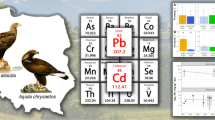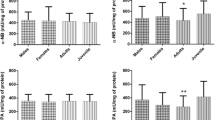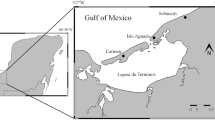Abstract
The current study aims to assess contaminant levels and tissue burdens in hooded seal (Cystophora cristata) blubber, liver, and blood in association with cytochrome P450 (CYP) enzymes (CYP1A and -3A) and serum analytes (hepatic enzymes like alanine aminotransferase [ALT], aspartate aminotransferase, alkaline phosphatase [AP], and γ-glutamyltransferase [GGT], serum proteins, and creatine kinase). Contaminant accumulation levels and patterns of polychlorinated biphenyls, chlorinated pesticides, and polybrominated diphenyl ethers (PBDEs) differed between tissues and seal groups, with the highest levels in liver. Pups showed higher liver contaminant levels, especially for PBDEs, than adults. These high levels might be associated with the ingestion of large amounts of contaminated milk and subsequent accumulation in the liver. Adult males and females mainly differed in PBDE levels, which were higher in females, possibly due to a sex-specific diet. The association between blubber contaminant burdens and the diagnostic enzymes ALT, GGT, and AP, and serum albumin, was inconclusive. In contrast, several CYP isoenzymes showed a clear positive relationship with the overall blubber contaminant burden, indicating enzyme induction following exposure to polyhalogenated hydrocarbons. Therefore, liver CYP isoenzymes may serve as a sensitive biomarker for long-term exposure to polyhalogenated hydrocarbons.




Similar content being viewed by others
References
AMAP (2002) AMAP assessment: persistent organic pollutants in the Arctic. Arctic Monitoring and Assessment Programme 2004, Oslo, Norway
Beck CA, Iversen SJ, Bowen WD (2005) Blubber fatty acids of gray seals reveal sex differences in the diet of a size-dimorphic marine carnivore. Can J Zool 83:377–388
Béland P, De Guise S, Girard C, Lagacé A, Martineau D, Michaud R, Muir DCG, Norstrom RJ, Pelletier É, Ray S, Shugart LR (1993) Toxic compounds and health and reproductive effects in St. Lawrence beluga whales. Great Lakes Res 19:766–775
Boily F, Beaudoin S, Measures LN (2006) Hematology and serum chemistry of harp (Phoca groenlandica) and hooded seals (Cystophora cristata) during the breeding season, in the Gulf of St. Lawrence, Canada. J Wildl Dis 42:115–132
Bossart GD, Dierauf LA (1990) Handbook of marine mammal medicine: health, disease, and rehabilitation. In: Dierauf LA (ed) Marine mammal clinical laboratory medicine. CRC Press, Boca Raton, FL, pp 1–52
Bossart GD, Reidarson TH, Dierauf LA, Duffield DA (2001) Handbook of marine mammal medicine In: Dierauf LA, Gulland FMD (ed) Clinical pathology. CRC Press, Boca Raton, FL, pp 383–436
Brouwer A, Reijnders PJH, Koeman JH (1989) PCB contaminated fish induces vitamin A and thyroid hormone deficiency in the common seal. Aquat Toxicol 15:99–106
Burke MD, Mayer RT (1974) Ethoxyresorufin: direct fluorimetric assay of a microsomal O-dealkylation which is preferentially inducible by 3-methylcholanthrene. Drug Metab Disp 2:583–588
Cabanac AJ (2000) Blood volume in hooded seals: implications for diving capacity. Can J Zool 78:1293–1299
Center SA, Randolph JF, ManWarren T, Slater M (1991) Effect of colostrum ingestion on gamma-glutamyltransferase and alkaline phosphatase activities in neonatal pups. Am J Vet Res 52:499–504
de Swart RL, Ross PS, Timmerman HH, Hijman WC, de Ruiter EM, Liem AKD, Brouwer A, van Loveren A, Reijnders PJH, Vos JG, Osterhaus ADME (1995) Short term fasting does not aggravate immunosuppression in harbour seal (Phoca vitulina) with high body burdens of organochlorines. Chemosphere 31:4289–4306
de Swart R, Ross P, Vos J, Osterhaus A (1996) Impaired immunity in harbour seals (Phoca vitulina) exposed to bio-accumulated environmental contaminants: review of a long-term study. Environ Health Perspect 104:823–828
Hall A (1998) Blood chemistry and hematology of gray seal (Halichoerus grypus) pups from birth to postweaning. J Zoo Wildl Med 29:401–407
Hall A, Pomeroy P, Green N, Jones K, Harwood J (1997) Infection, haematology and biochemistry in grey seal pups exposed to chlorinated biphenyls. Mar Environ Res 43:81–98
Jeong HG, Lee SS (1998) Suppressive effects of estradiol on 2,3,7,8-tetrachloro-p-dioxin-mediated transcriptional activation of murine CYP1A-1 in mouse hepatoma hepa 1c1c7 cells. Cancer Lett 133:177–184
Legendre P, Legendre L (1998) Numerical ecology, 2nd edn. Elsevier Science BV, Amsterdam
Lowry OH, Rosebrough AL, Farr AL, Randle RJ (1951) Protein measurements with the Folin phenol reagents. J Biol Chem 193:265–267
Lydersen C, Wolkers H, Severinsen T, Kleivane L, Nordoy ES, Skaare JU (2002) Blood is a poor substrate for monitoring pollution burdens in phocid seals. Sci Tot Environ 292:193–203
Medway W, Geraci JR (1986) Clinical pathology of marine mammals. In: Fowler ME (ed) Zoo and wild animal medicine, 2nd edn. W. B. Saunders, Philadelphia, pp 791–797
Milsap RL, Jusko WJ (1994) Pharmacokenetics ih the infant. Environ Health Perspect 102:107–110
Miyai K (1991) Structural organization of the liver. In: Meeks RG, Harrison SD, Bull RJ (eds) Hepatotoxicology. CRC Press, Boca Raton, FL, pp 1–66
Nakashima Y, Ohsawa S, Umegaki K, Ikegami S (1997) Hexachlorobenzene accumulated by dams during pregnancy is transferred to suckling rats during early lactation. J Nutr 127:648–654
Nordøy ES, Thoresen SI (2002) Reference values for serum biochemical parameters in free-ranging harp seals. Vet Clin Path 31:98–105
Nyman M, Bergknut M, Fant ML, Raunio H, Jestoi M, Bengs C, Murk A, Koistinen J, Backman C, Pelkonen O, Tysklind M, Hirvi T, Helle E (2003) Contaminant exposure and effects in Baltic ringed and grey seals as assessed by biomarkers. Mar Environ Res 55:73–99
Osweiler GD (1996) Toxicology of the liver and biliary system. In: Toxicology. Williams and Wilkins, Philadelphia, pp 87–97
Peakall DB (1992) A practical basis for using physiological indicators in environmental assessment. Ambio 21:437–438
Reijnders PJH (1986) Reproductive failure of common seals (Phoca vitulina) feeding on fish from polluted coastal water. Nature 324:456–457
Reijnders PJH (1988) Ecotoxicological perspectives in marine mammalogy: research principles and goals for a conservation policy. Mar Mamm Sci 4:91–102
Reijnders PJH (1990) Progesterone and oestradiol-17β concentration profiles throughout the reproductive cycle in harbour seals (Phoca vitulina). J Reprod Fert 90:403–409
Ross P, de Swart R, Addison R, van Loveren H, Vos J, Osterhaus A (1996) Contaminant-induced immunotoxicity in harbour seals (Phoca vitulina): wildlife at risk? Toxicology 112:157–169
Rutten AJJL, Falke HE, Catsburg JF, Topp R, Blaauboer BJ, van Holsteijn I, Doorn L, van Leeuwen FXR (1987) Interlaboratory comparison of total cytochrome P450 and protein determination in rat liver microsomes. Arch Toxicol 61:27–33
Ryg M, Lydersen C, Markussen NH, Smith T, Øritsland NA (1990) Estimating the blubber content of phocid seals. Can J Fish Aquat Sci 47:1223–1227
Schumacher U, Heidemann G, Skírnisson K, Schumacher W, Pickering RM (1995) Impact of captivity and contaminant level on blood parameters of harbour seals (Phoca vitulina). Comp Biochem Physiol 112A:455–462
Severinsen T, Skaare JU, Lydersen C (2000) Spatial distribution of persistent organochlorines in ringed seal (Phoca hispida) blubber. Mar Environ Res 49:291–302
Silkworth JB, Koganti A, Illouz K, Possolo A, Zhao M, Hamilton SB (2005) Comparison of TCDD and PCBCYP1A induction sensitivities in fresh hepatocytes from human donors, Sprague-Dawley rats, and rhesus monkeys and HepG2 cells. Toxicol Sci 87:508–519
St. Aubin D, Geraci JR (1977) Tissue distribution and plasma levels of liver enzymes in phocid seals. Can J Zool 55:1936–1941
Stegeman JJ, Pajor AM, Thomas P (1982) Influence of estradiol and testosterone on cytochrome P450 and monooxygenase activity in immature brook trout (Salvelinus fontinalus). Biochem Pharmacol 31:3979–3989
Trumble SJ, Castellini MA (2002) Blood chemistry, hematology and morphology of wild harbour seal pups in Alaska. J Wildl Manage 66:1197–1207
Tryland M, Krafft BA, Lydersen C, Kovacs KM, Thoresen SI (2006) Serum chemistry values for free-ranging ringed seals (Pusa hispida) in Svalbard. Vet Clin Path 35:405–412
Turk JR, Casteel SW (1997) Clinical biochemistry in toxicology. In: Kaneko JJ, Harvey JW, Brus ML (eds) Clinical biochemistry of domestic animals, 5th edn. Academic Press, San Diego, CA, pp 829–843
Wolkers J, Jorgensen EH, Nijmeijer SM, Witkamp RF (1996) Time-dependent induction of two distinct hepatic cytochrome P4501A catalytic activities at low temperatures in Arctic charr (Salvelinus alpinus) after oral exposure to benzo(a)pyrene. Aquat Toxicol 35:127–138
Wolkers J, Witkamp RF, Nijmeijer SM, Burkow IC, de Groene EM, Lydersen C, Dahle S, Monshouwer M (1998a) Phase I and phase II enzyme activities in ringed seals (Phoca hispida): characterization of hepatic cytochrome P450 by activity patterns, inhibition studies, mRNA analyses, and western blotting. Aquat Toxicol 44:103–115
Wolkers J, Burkow IC, Lydersen C, Dahle S, Monshouwer M, Witkamp RF (1998b) Congener specific PCB and polychlorinated camphene (toxaphene) levels in Svalbard ringed seals (Phoca hispida) in relation to sex, age, condition and cytochrome P450 enzyme activity. Sci Tot Environ 216:1–11
Wolkers J, Burkow IC, Monshouwer M, Lydersen C, Dahle S, Witkamp RF (1999) Cytochrome P450-mediated enzyme activities and polychlorinated biphenyl accumulation in harp seal (Phoca groenlandica). Mar Environ Res 48:59–72
Wolkers H, Burkow IC, Lydersen C, Witkamp RF (2000) Chlorinated pesticide concentrations, with an emphasis on polychlorinated camphenes (toxaphenes), in relation to cytochrome P450 enzyme activities in harp seals (Phoca groenlandica) from the Barents Sea. Environ Toxicol Chem 19:1632–1637
Wolkers H, Burkow IC, Hammill MO, Lydersen C, Witkamp RF (2002) Transfer of polychlorinated biphenyls and chlorinated pesticides from mother to pup in relation to cytochrome P450 enzyme activities in harp seals (Phoca groenlandica) from the Gulf of St. Lawrence, Canada. Environ Toxicol Chem 21:94–101
Wolkers J, Hammill MO, Bavel B (2006) Tissue-specific accumulation and lactational transfer of PCBs, chlorinated pesticides, and brominated flame retardants in hooded seals (Cystophora cristata) from the Gulf of St. Lawrence: applications fro monitoring. Environ Pollut 142:476–486
Wortelboer HM, De Kruif CA, Van Iersel AAJ, Falke HE, Noordhoek J, Blaauboer BJ (1990) The isoenzyme pattern of cytochrome P450 in rat hepatocytes in primary culture, comparing different enzyme activities in microsomal incubations and intact monolayers. Biochem Pharmacol 40:2525–2534
Worthy GAJ, Lavigne DM (1982) Changes in blood properties of fasting and feeding harp seal pups, Phoca groenlandica, after weaning. Can J Zool 60:586–592
Acknowledgments
We thank Dr. L. Measures and Dr. S. Beaudoin for permission to use the hooded seal blood chemistry data. S. Beaudoin also provided helpful comments on the clinical pathology. This work was funded by the Norwegian Polar Institute, the Canadian Department of Fisheries and Oceans, and a Canadian Biotechnology Strategy grant to L. Measures.
Author information
Authors and Affiliations
Corresponding author
Rights and permissions
About this article
Cite this article
Wolkers, H., Boily, F., Fink-Gremmels, J. et al. Tissue-Specific Contaminant Accumulation and Associated Effects on Hepatic Serum Analytes and Cytochrome P450 Enzyme Activities in Hooded Seals (Cystophora cristata) from the Gulf of St. Lawrence. Arch Environ Contam Toxicol 56, 360–370 (2009). https://doi.org/10.1007/s00244-008-9186-6
Received:
Accepted:
Published:
Issue Date:
DOI: https://doi.org/10.1007/s00244-008-9186-6




